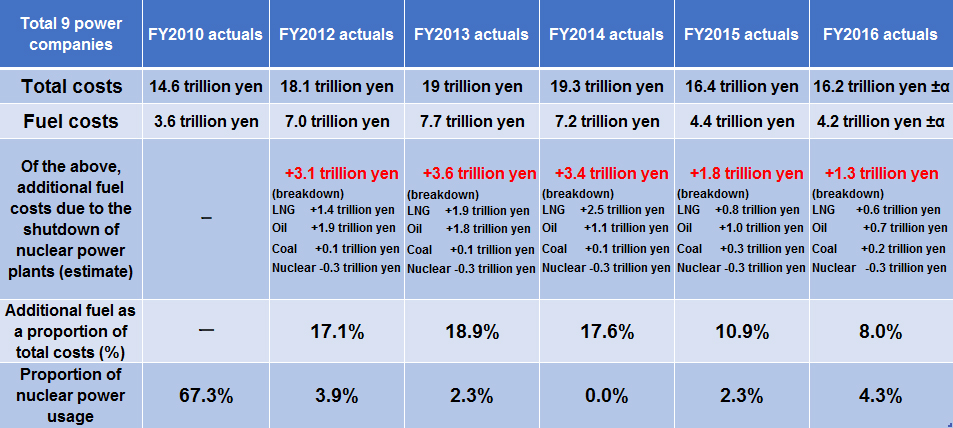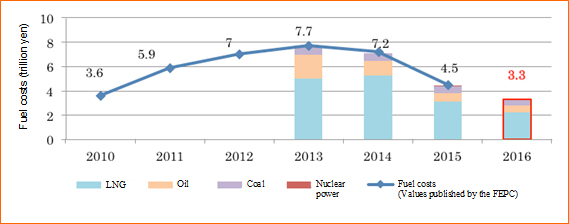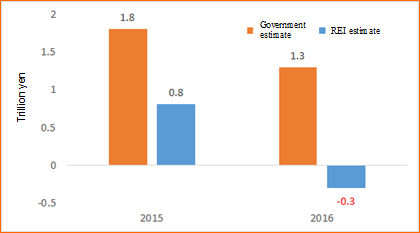A Comparative Analysis of the Government's Estimate of "The Outflow of National Wealth due to the Shutdown of Nuclear Power Plants" (2016)
A reduction in fuel costs even with the shutdown of nuclear power plants
in Japanese
In Japan, almost all nuclear power plants have been shut down since the accident at Tokyo Electric Power Company's Fukushima Daiichi Nuclear Power Plant in March 2011. At present, only two reactors are working -- Sendai Nuclear Power Station Unit 2 (PWR, 890MW, Kyushu Electric Power Co.) and Ikata Nuclear Power Station Unit 3 (PWR, 890MW, Shikoku Electric Power Co.). In 2010, nuclear power plants accounted for around 30% of Japan's total electricity generation, but they now produce 1 - 2%.
Because of this, over the last few years, the Ministry of Economy, Trade and Industry has been asserting in its Electricity Supply-Demand Verification Subcommittee, etc. that "Due to the shutdown of nuclear power plants, dependence on imported fuel has increased, and ‘between 3 trillion and 7 trillion yen of national wealth is draining out of the country.’"
In response, Renewable Energy Institute has provided evidence arguing against this figure in its "Three issues with the Basic Energy Plan" (September 2013, Japanese only), "Is the Shutdown of Nuclear Reactors Really Costing 3.6 Trillion Yen? A Comparative Analysis of the Government's Fuel Cost Estimate" (March 2014), and the November 2015 column "Is the Shutdown of Nuclear Reactors Really Costing 3.6 Trillion Yen? A Comparative Analysis of the Government's Fuel Cost Estimate (2015)." The Institute has now carried out a comparative analysis of the 2016 estimate, for a year in which the prices of imported fuels fell significantly.
Outline of the government's estimate and points at issue
The Basic Policy Subcommittee on Electricity and Gas (hereinafter, "the Subcommittee") of the Ministry of Economy, Trade and Industry's Agency for Natural Resources and Energy estimates the cost of the extra fuel which needed to be burnt at thermal power plants in FY2016 as the result of the shutdown of nuclear power plants at 1.3 trillion yen in its "Electricity Supply-Demand Verification Report" (25 October 2016). The Subcommittee goes on to say that the average burden on each Japanese citizen will be around 10,000 yen greater due to these additional fuel costs.
However, this estimate from the Subcommittee is far removed from reality, and is an arbitrary figure based on an overestimate of the volume of additional fuel burnt at thermal power plants.
Fig.1 Basic Policy Subcommittee on Electricity and Gas estimate of additional fuel costs due to the shutdown of nuclear power plants

Source: quoted from the Electricity Supply-Demand Verification Report (Basic Policy Subcommittee on Electricity and Gas, October 2016)
The Subcommittee's estimate is based on the assumptions that all nuclear power plants are in operation, and that the equivalent amount of electricity is generated as a replacement by "burning additional fuel at thermal power plants". Specifically, the "additional fuel burnt due to the shutdown of nuclear power plants” is calculated based on the amount of electricity generated by nuclear power before the Great East Japan Earthquake, 274.8 billion kWh (the average annual amount of electricity generated by nuclear power between FY2008 and FY2010), minus the 9.4 billion kWh generated by the restarted nuclear power plants last fiscal year.
However, the government's assumption that the amount of electricity generated by nuclear power would be the same as that prior to 2010 completely fails to take into account the increase in electricity supplied by renewable energy or the decrease in demand due to energy savings and efficiency, and supposes that without restarting nuclear power plants, the estimated "additional fuel burnt" by thermal power plants will not decrease. In reality, however, both energy savings and efficiency and the growth of renewable energy have made great advances since 2011, and have begun to make up for the electricity formerly generated by nuclear power.
For example, comparing FY2010 and FY2015 figures in the Subcommittee's estimate, we see that the "additional fuel burnt as the result of the shutdown of nuclear power plants" is assumed to be 266.1 billion kWh (the sum obtained by subtracting the amount of electricity generated by the restarted nuclear power plants from 274.8 billion kWh). However, if we compare the actual amount of electricity generated and purchased by the 10 power companies in FY2010 and FY2015, the amount of electricity generated by thermal power increased by 126.8 billion kWh, less than half of the Subcommittee's estimate. ⅰ This is because energy savings and efficiency adopted after the Great East Japan Earthquake and renewable energy are making up for the shortfall left by the shutdown of nuclear power plants. ⅱ
Since the Subcommittee's fuel cost estimates are based on assumptions of "additional fuel burnt at thermal power plants" that greatly exceed actual levels, the increase in fuel costs is far removed from reality.
Estimate of actual fuel costs by Renewable Energy Institute
While the government's estimate rests on the unfounded assumption that the status of nuclear power operations would be equivalent to 2010 and before, Renewable Energy Institute has calculated estimated fuel costs based on the actual amount of electricity generated by thermal power. It has become clear that by using the data published each fiscal year on the amount of electricity generated by thermal power plants using different fuels and the annual unit prices for such fuel reported by the Electricity Supply-Demand Verification Subcommittee, it is possible to virtually replicate fuel costs for the generation of electricity at thermal power plants.
Fig.2 shows data published by the Federation of Electric Power Companies of Japan (FEPC) on actual fuel costs for 10 power companies (line graph) and fuel cost estimates calculated by Renewable Energy Institute (stacked bar graph). Looking at this graph, it can be seen that the fuel costs for FY2013 to FY2015 have been virtually replicated. Further, in this estimate, fuel costs for FY2015 are 4.5 trillion yen, growing around 900 billion yen in comparison with the 3.6 trillion yen in FY2010, an increase which is less than the 1.8 trillion yen in the government estimate (see Fig.1).
Fig.2 Actual fuel costs for the 10 power companies from the Federation of Electric Power Companies of Japan (line graph) and fuel cost estimates from Renewable Energy Institute (stacked bar graph)

Forecast for 2016 fuel costs
Furthermore, when Renewable Energy Institute estimated fuel costs for a scenario in which the amount of electricity generated by LNG, oil, coal and nuclear in FY2016 were the same as those for FY2015, and using FY2016 fuel prices given in the "Electricity Supply-Demand Verification Report," fuel costs for FY2016 came to 3.3 trillion yen. This sum is less than the 3.6 trillion yen spent on fuel in FY2010, resulting instead in savings of 300 billion yen.
Fig.3 Comparison of government and Renewable Energy Institute estimates of costs for "additional fuel burnt at thermal power plants"

* Estimates of "costs of additional fuel burnt" from FY2010 to FY2015 and FY2016
In conclusion, the government's estimates of fuel costs define "the volume of additional fuel burnt at thermal power plants" not according to the actual increase in electricity produced but as the amount no longer generated by the nuclear power plants which have been shut down, leading to an overestimation of the influence of this shutdown, and furthermore, misleading that restarting these plants is the only way to reduce fuel costs.
As Renewable Energy Institute's estimates make clear, the actual amount of electricity generated by thermal power is decreasing due to the progress of energy savings and efficiency and the growth of renewable energy. As the prices of imported fuels, which reached high levels in recent years, returned to levels before the Great East Japan Earthquake, the fuel cost required by thermal power plants also fell.
Moreover, the most certain way to lower fuel costs further is not to depend on restarting nuclear power plants, an uncertain quantity, but rather to press ahead with the expansion of energy savings and efficiency and renewable energy so that they come to replace the generation by thermal power.
ⅰ A comparison of the amount of generating-end by thermal power for the 10 power companies, including that which they purchased from other companies, taken from data published by the Federation of Electric Power Companies of Japan.
ⅱ It can also be thought that a shift in demand for electricity to other new power companies has had an influence.

